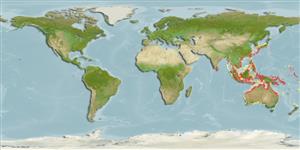Environment: milieu / climate zone / depth range / distribution range
Ecologia
marinhas; estuarina; intervalo de profundidade 0 - ? m. Tropical
Western Central Pacific: replaces the coastal Hyporhamphus (Hyporhamphus) limbatus in waters around Java, Sumatra, Borneo and the Philippines. Also known from the middle of the eastern coast of Queensland, Arnhem Land, Northern Territory, and the northern part of Western Australia, and from offshore islands (Ref. 10988).
Length at first maturity / Tamanho / Peso / Idade
Maturity: Lm 12.6, range 10 - 14.9 cm
Max length : 16.5 cm SL macho/indeterminado; (Ref. 9843)
Descrição breve
Morfologia | Morfometria
Espinhos dorsais (total): 0; Raios dorsais moles (total): 13-16; Espinhos anais 0; Raios anais moles: 14 - 17; Vértebras: 47 - 53. Gill rakers usually 31 or fewer on the first arch, and usually 23 or fewer on the second arch.
Occasionally marketed fresh in the Philippines.
Life cycle and mating behavior
Maturidade | Reprodução | Desova | Ovos | Fecundidade | Larvas
Collette, B.B., 1974. The garfishes (Hemiramphidae) of Australia and New Zealand. Records of the Australian Museum 29(2):11-105. (Ref. 10988)
Categoria na Lista Vermelha da IUCN (Ref. 130435)
Ameaça para o homem
Harmless
Utilização humana
Mais informação
ReferênciasAquaculturaPerfil para aquaculturaEstirpesGenéticaElectrophoresesHereditariedadeDoençasProcessamentoNutrientsMass conversion
ColaboradoresFotografiasStamps, Coins Misc.SonsCiguateraVelocidadeTipo de nataçãoÁrea branquialOutras referênciasCérebrosVisão
Ferramentas
Relatórios especiais
Descarregue XML
Fontes da internet
Estimates based on models
Preferred temperature (Ref.
123201): 24.6 - 29.3, mean 28.6 °C (based on 2489 cells).
Phylogenetic diversity index (Ref.
82804): PD
50 = 0.5000 [Uniqueness, from 0.5 = low to 2.0 = high].
Bayesian length-weight: a=0.00339 (0.00181 - 0.00635), b=3.06 (2.90 - 3.22), in cm total length, based on LWR estimates for this species & Genus-body shape (Ref.
93245).
Nível Trófico (Ref.
69278): 3.0 ±0.4 se; based on size and trophs of closest relatives
Resiliência (Ref.
120179): Elevada, tempo mínimo de duplicação da população menor que 15 meses (Preliminary K or Fecundity.).
Fishing Vulnerability (Ref.
59153): Low vulnerability (10 of 100).
